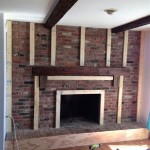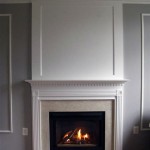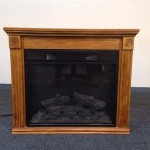Ceramic Tile Fireplace: Aesthetics, Functionality, and Installation
A fireplace serves as a focal point in many homes, providing both warmth and aesthetic appeal. Ceramic tile, renowned for its versatility, durability, and design options, has become an increasingly popular choice for fireplace surrounds, hearths, and even full fireplace facades. This article will explore the advantages of using ceramic tile in fireplace design, discuss key considerations for installation, and highlight some popular design trends within this realm.
Ceramic tile, in its basic form, is composed of clay and other natural materials that are fired at high temperatures. This process creates a hard, durable surface resistant to heat, moisture, and wear. Unlike some other materials used in fireplace construction, ceramic tile is relatively low maintenance and can be easily cleaned. Its broad range of colors, sizes, shapes, and textures allows for extensive design customization, making it suitable for a variety of architectural styles, from traditional to contemporary.
Advantages of Utilizing Ceramic Tile for Fireplaces
Several key advantages make ceramic tile a compelling material choice for fireplace projects. These benefits relate to its functional properties, aesthetic flexibility, and long-term value.
Firstly, and perhaps most critically for a fireplace application, ceramic tile is inherently fire-resistant. While not completely impervious to extreme heat, ceramic tile can withstand the fluctuating temperatures associated with fireplace use better than many other surface materials. This resistance protects the underlying structural components of the fireplace and contributes to overall home safety. Furthermore, ceramic tile does not emit harmful fumes when heated, ensuring good indoor air quality.
Secondly, ceramic tile offers unparalleled design versatility. The sheer range of available colors, patterns, sizes, and finishes allows homeowners and designers to achieve virtually any desired aesthetic. From classic subway tiles to intricate mosaic designs, from rustic textured tiles to sleek, modern large-format panels, the options are seemingly endless. This adaptability allows the fireplace to seamlessly integrate with the surrounding decor and become a true reflection of personal style. The ability to mimic the appearance of natural stone, brick, or wood at a lower cost and with improved durability is another significant advantage.
Thirdly, ceramic tile is known for its ease of maintenance. Its smooth, non-porous surface resists stains, spills, and soot buildup. Regular cleaning with mild soap and water is typically sufficient to keep the tile looking its best. Unlike natural stone, ceramic tile generally does not require sealing or special treatments. This low-maintenance characteristic contributes to the long-term value and appeal of a ceramic tile fireplace.
Finally, when properly installed, ceramic tile is a durable and long-lasting material. It can withstand daily wear and tear, resisting scratches, chips, and fading. This durability ensures that the fireplace will maintain its beauty and functionality for many years to come, making it a worthwhile investment for homeowners.
Key Considerations for Ceramic Tile Fireplace Installation
Proper installation is crucial to ensure the longevity, safety, and aesthetic appeal of a ceramic tile fireplace. Several key considerations must be addressed during the planning and execution phases of the project.
First, adequate surface preparation is paramount. The substrate, which is the surface to which the tile will be adhered, must be clean, level, and structurally sound. This typically involves removing any existing finishes, repairing any cracks or imperfections, and applying a cement backer board, which provides a stable and moisture-resistant base for the tile. Uneven or unstable substrates can lead to tile cracking, loosening, or even complete failure.
Second, selecting the appropriate mortar and grout is essential. The mortar must be specifically designed for use with ceramic tile and capable of withstanding the high temperatures associated with fireplace use. Heat-resistant mortars are readily available and should be used in all areas directly exposed to the fire. Similarly, the grout should be durable, stain-resistant, and appropriately colored to complement the tile. Epoxy grout is often recommended for its superior performance in high-traffic and high-moisture areas.
Third, proper tile layout and cutting are critical for achieving a professional and visually appealing result. Careful planning is necessary to ensure that the tile is evenly distributed across the surface and that any cuts are clean and precise. Special tools, such as tile saws and nippers, are required for cutting and shaping the tile. The layout should consider the placement of grout lines and any decorative accents. Incorrect layout can result in awkward cuts, uneven spacing, and an overall unprofessional appearance.
Fourth, accounting for expansion and contraction is vitally important. Fireplaces experience significant temperature fluctuations, which can cause the tile and underlying materials to expand and contract. To prevent cracking or buckling, expansion joints should be incorporated into the design, particularly around the perimeter of the tiled area and at any points where the tile meets other materials, such as wood or drywall. These joints are typically filled with a flexible sealant that can accommodate movement without compromising the integrity of the tile installation.
Fifth, adherence to building codes and safety regulations is non-negotiable. Fireplace installations must comply with local building codes, which often specify requirements for fire-resistant materials, clearances to combustible objects, and ventilation. It is also essential to follow the manufacturer's instructions for all materials used in the installation. Failure to comply with these regulations can result in safety hazards, property damage, and legal liabilities.
Current Design Trends in Ceramic Tile Fireplaces
The world of fireplace design is constantly evolving, with new trends emerging regularly. Several current trends are particularly prominent in ceramic tile fireplace design.
One popular trend is the use of large-format tiles. These oversized tiles create a seamless, modern look and minimize the number of grout lines, resulting in a cleaner and more sophisticated aesthetic. Large-format tiles are available in a variety of materials, including porcelain, which is known for its durability and moisture resistance. Their size makes them ideal for covering large fireplace facades and creating a dramatic statement.
Another trend is the incorporation of textured tiles. Textured tiles add depth and visual interest to the fireplace, creating a tactile and inviting feel. These tiles are available in a wide range of textures, from subtle ripples to bold geometric patterns. They can be used to create a rustic, natural look or a contemporary, minimalist design. The play of light and shadow on the textured surface adds to the overall aesthetic appeal.
A third trend is the use of mosaic tiles. Mosaic tiles, with their intricate patterns and vibrant colors, offer endless design possibilities. They can be used to create a focal point in the fireplace design or to add a touch of whimsy and personality. Mosaic tiles are available in a variety of materials, including glass, ceramic, and stone. They can be used to create intricate murals, geometric designs, or abstract patterns.
A fourth trend involves incorporating natural stone look-alike tiles. These tiles mimic the look and feel of natural stone, such as marble, granite, or slate, but offer the added benefits of ceramic tile, such as lower cost, easier maintenance, and greater durability. Natural stone look-alike tiles are available in a wide range of colors and patterns, allowing homeowners to achieve the desired aesthetic without the expense and upkeep associated with natural stone.
Finally, minimalist fireplace designs are gaining popularity. These designs focus on clean lines, simple shapes, and neutral colors. The goal is to create a serene and uncluttered space that complements the overall decor of the room. Ceramic tile is often used in minimalist fireplace designs to create a smooth, seamless surface that blends seamlessly with the surrounding walls.
In conclusion, ceramic tile offers a compelling combination of aesthetic appeal, functional advantages, and design versatility for fireplace applications. Careful consideration of installation techniques and current design trends is essential to achieve a successful and visually stunning result.

Hottest Fireplace Trend Tile Flooring America

Planning A Tile Fireplace Budgeting Design Diy Vs Pro

How To Tile A Fireplace My Uncommon Slice Of Suburbia

Fireplace Tiles Ideas And Patterns Rubi Blog Usa

5 Tips For Designing Fireplaces With Cement Or Ceramic Tile Belk

Hot Fireplace Tile Trends Bedrosians Stone
Fireplace Tile Surround 5 Decorative Mantel Tiles 2024

14 Fresh Designs For Tiled Fireplaces Bob Vila

Fireplace Tile With Leaf Tiles Custom Available Botanical Woodland Arts And Crafts Style Rustic Cabin Bungalow

Modern Fireplace Makeover Tile Small
Related Posts








